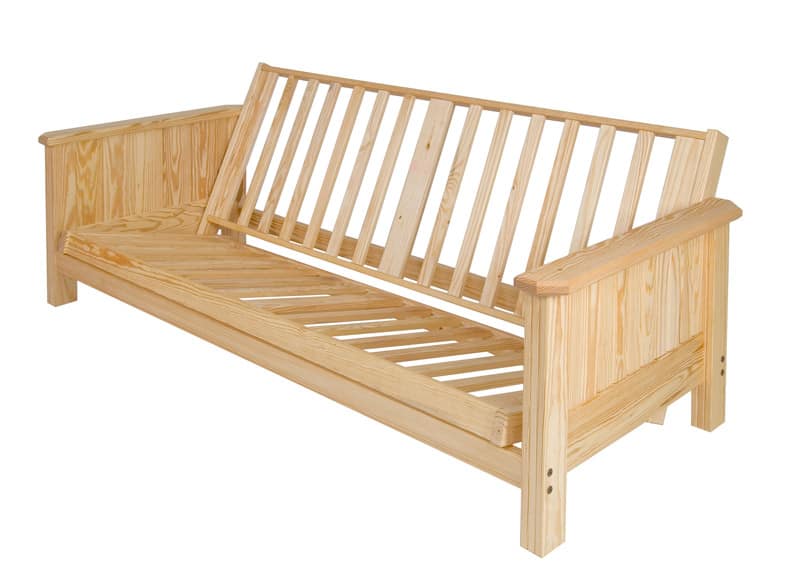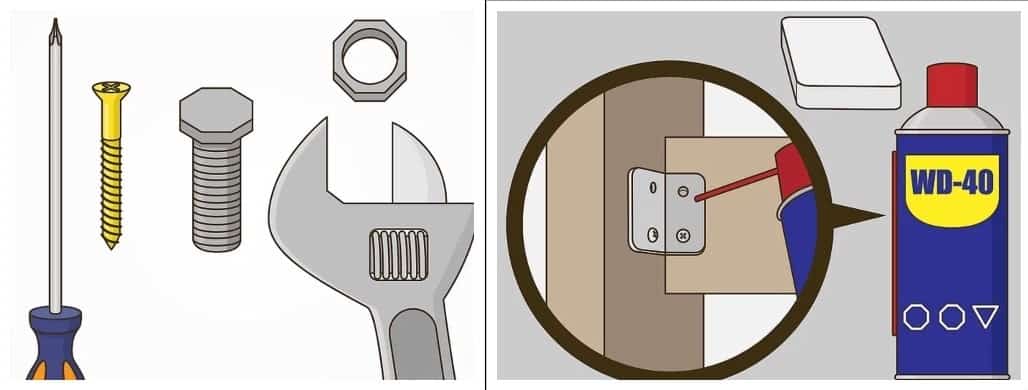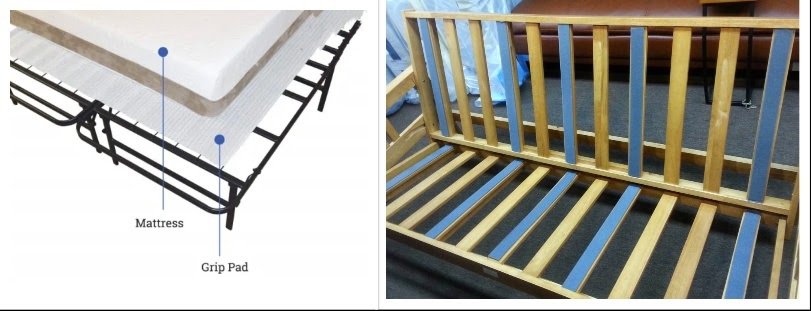Futons are versatile pieces of furniture that are able to convert from a couch to a bed, and vice versa. Futons consist of a metal or wooden frame, a mattress for sitting and sleeping, and an upholstered cover. Take a look at our article How do Futons Work for more detailed information on different types of futons and tips and tricks to make a futon more comfortable. Typically, wooden futon frames are sturdier, more aesthetically pleasing, and may last longer than metal futon frames. Metal futon frames, on the other hand, may be lightweight and less sturdy than solid wood. Whether they are made of metal or wood, futons will generally start squeaking over time, and these squeaking noises may disturb you while you’re sitting or sleeping on the futon. But how do you fix a squeaky futon?
To fix a squeaky futon, follow these steps:
-
- Step 1: Locate the source of the squeaking
- Step 2: Replace any broken hinges or gliders
- Step 3: Tighten and lubricate the joints
- Step 4: Lubricate the edges of the futon frame
- Step 5: Repair or replace weak or bent slats
- Step 6: Stuff any gaps
We’ll discuss these steps in more detail below.
Why Does My Futon Squeak?
 Metal and wooden futons may squeak for different reasons. Image from Room Doctor.
Metal and wooden futons may squeak for different reasons. Image from Room Doctor.A futon may squeak for a variety of reasons. Many futons squeak because of weakened joints due to frequent use, broken elements, or lack of lubrication. These reasons may vary depending on which type of futon frame you have and the material it’s made out of.
Reasons Why a Metal Futon Frame May Squeak
Over time, metal futons will wear out, just like anything else made of metal or steel. Frequent use of a futon will cause the connectors to loosen, and these weak joints may cause metal elements to rub up against each other, causing squeaking noises. The seat and back decks of metal futon frames are made of fine metal piping. Sometimes, it might be the futon mattress rubbing against the decks that causes squeaking when you move on the mattress.
Reasons Why a Wooden Futon Frame May Squeak
Over time, your wooden futon frame may also start squeaking. This may be caused by metal components in the wood pieces rubbing against each other under the pressure of your mattress, which can be a result of frequent use. Squeaking noises from a wooden futon can also be caused by a gap between the mattress and the wooden decks of the futon frame.
Now that you know why a futon may be squeaking, follow the steps below to fix a squeaky futon.
Step 1. Locate the Source of the Squeaking To Fix a Squeaky Futon
In order to fix a squeaky futon, we first need to locate the source of the squeaking.
Pull the futon open into the bed mode. If you hear squeaking and the mattress gets stuck and doesn’t open properly, then one of the hinges or gliders of the metal futon may be damaged. Replace them with new ones to fix this issue (see step 2 below).
However, if your futon unfolds properly, move on to examine the mattress and the frame.
Remove the mattress and lay it on the floor to test whether it squeaks. If the mattress is an innerspring mattress, then the deterioration of the springs due to constant pressure may be responsible for the squeaking. However, if you have another type of mattress, the squeaking will be coming from somewhere else.
Inspect the futon frame. The frame holds slat racks together, and the decks are made of either wood or metal and are connected with nuts and screws. Sit on the decks and apply pressure on different areas. If the frame is unsteady and is also squeaking, the solution may be to tighten and lubricate the joints (see step 3).
If your futon has a wooden frame, temperature changes and moisture can cause the wood to swell or shrink. This may cause the wood to creak and rub against other wooden pieces in the futon frame. Lubricate the squeaky areas to prevent one wooden piece from rubbing against another (see step 4).
Check for signs of cracking or bending in the slat racks. Weak or damaged slats may be the reason for the squeaking. You can replace or repair the slats with glue (see step 5).
Sometimes squeaking results from friction between the mattress and the futon frame. Make sure to prevent any friction by padding the area between the two components (see step 6).
Step 2. Replace Any Broken Hinges or Gliders
Metal futons rely on rollers and hinges to allow it to smoothly unfold and convert into a bed. If there is a problem with the folding mechanism and your futon is not opening or closing properly, then the hinge on one side of the frame is likely to be damaged or broken. This damaged hinge or glider could cause your futon to make squeaking noises. Replace the hinges and the gliders on both sides of the frame with new ones (here’s an example of hinges from Amazon), even if you only have one that’s damaged. This will keep both sides in sync.
Step 3. Tighten and Lubricate the Joints
 You can use a wrench or a screwdriver to tighten joints, and a lubricant to eliminate squeaking. Image from WikiHow.
You can use a wrench or a screwdriver to tighten joints, and a lubricant to eliminate squeaking. Image from WikiHow. If your futon is wobbling, check the bolts that connect the different parts of the futon. Remove the nuts and bolts and add plastic washers between them. Reinsert the nuts and bolts into place and tighten them using a wrench or a screwdriver. Then, spray lubricating oil on the area; use WD-40 or any mineral oil solution to lubricate metal connectors and surfaces. If you don’t have oil, use a waxy substance like a candle or a brick of paraffin to coat the threads of the bolts and screws and muffle any squeaking sounds.
Step 4. Lubricate the Edges of the Futon Frame
Step 5. Repair or Replace Weak or Bent Slats
Check if the futon’s slats are intact or if they’re damaged. If there are slats that are shifted or broken, they may be causing the squeaking noises when you toss and turn on the futon. Remove any bent slats gently with your hand, or unscrew the slats if they are tightly attached to the boards and frame. Replace the broken slats with pieces of plywood or glue them back together with wood glue (here’s an example from Amazon).
Make sure that all the slats are evenly spaced and have less than two inches between them to prevent them from digging into the mattress and causing squeaking sounds. Broken slats can also prevent your futon from supporting you properly while you sleep, which can affect your spinal alignment. For more information on proper spinal alignment, see this study published in Clinical Neurology and Neurosurgery.
Step 6. Stuff Any Gaps
 Be sure to stuff any gaps between your mattress and slats in your futon to prevent squeaking. Image from Made-in-China.
Be sure to stuff any gaps between your mattress and slats in your futon to prevent squeaking. Image from Made-in-China.When the mattress slides on the slat rack and is not fixed in a certain spot, it will rub against the frame and cause squeaking sounds. To avoid this, pad the squeaky area along each slat or metal bar with fabric like old socks, a hardcover book, or sheets of cork. You can also prevent the mattress from sliding and rubbing on the decks by adding a mattress grip pad (here’s an example) or a non-slip futon strip (here’s an example). If you find your mattress is sagging, take a look at how to fix a sagging futon mattress. Once you fix the squeaks and the sagging, make sure to clean your futon mattress too! Take a look at our comprehensive article, How to Clean Your Futon Mattress to find step-by-step instructions. Additionally, if you or someone you know has to use a futon while pregnant, take a look at our 6 tips to sleeping on a futon while pregnant for some ideas on making it a better experience!
Are you in the market for an updated futon mattress? Take a look at our comprehensive guide to the best futon mattresses with reviews and our ultimate guide to futon frame, mattress, and sheet sets before making a decision.
